In Salesforce’s State of the Connected Customer report, 54% of respondents said “it generally feels like sales, service, and marketing don’t share information,” while 86% reported the societal role of companies is changing.
In this age of digital transformation and hyper-personalized experiences, customer satisfaction has been the prime focus for most businesses. The good news is that we now have Salesforce CDP and MuleSoft connectors that have the power to connect external customer data sources to provide optimal customer experiences.
Salesforce CDP bundles together all data points about an individual customer across multiple platforms, simply using a unique identifier. True to its name and nature, a customer data platform (CDP) connects all customer interactions and provides insights into the customer data.
The MuleSoft-Salesforce CDP Connector provides Mule users a quick and easy integration approach to connect Salesforce CDP API endpoints. Together, Salesforce CDP and MuleSoft can unleash the power of your marketing and sales CRM to unite backend business units to deliver the connected data-based API-led approach that customers expect and businesses can benefit from.
We’re going to take a deep dive into what problems Salesforce CDP solves and present a high-level, technical perspective. We will also get into the details of integrating to CDP using MuleSoft.
Defining a customer data platform
Poorly integrated customer master data is a problem that IT teams often have to solve. The evolution of application integration, data integration, and industry data models promise both an easily acquired set of components with a built-in data model and flexibility to supplement this data model with information that resides in external systems. This category of software is called customer master data management (MDM).
CDP as a system of insight
Salesforce CDP is not so much a data platform as a data analysis platform focused on the needs of marketing teams. CDP is not a transactional primary source of customer records, but a system into which customer information is loaded and analyzed.
While CDP is not an MDM, it can and should work alongside a customer MDM. CDP has out-of-the-box connections to Salesforce core objects and can use Salesforce CRM as an initial source of customer master data. Salesforce CDP, therefore, should be categorized as a System of Insight (SOI).
SOIs integrate data in the systems of engagement and systems of records to find new relationships and patterns by analyzing historical data, assessing the current situation, applying business rules, predicting outcomes, and proposing the next best action. Systems of Insight are analysis systems that enable the gathering, mining, organizing, transforming, consuming, and analyzing diverse sets of data with statistical modeling tools. This helps to detect patterns, report on what has happened, predict outcomes with a high degree of confidence, apply business rules and policies, and provide actionable insights.
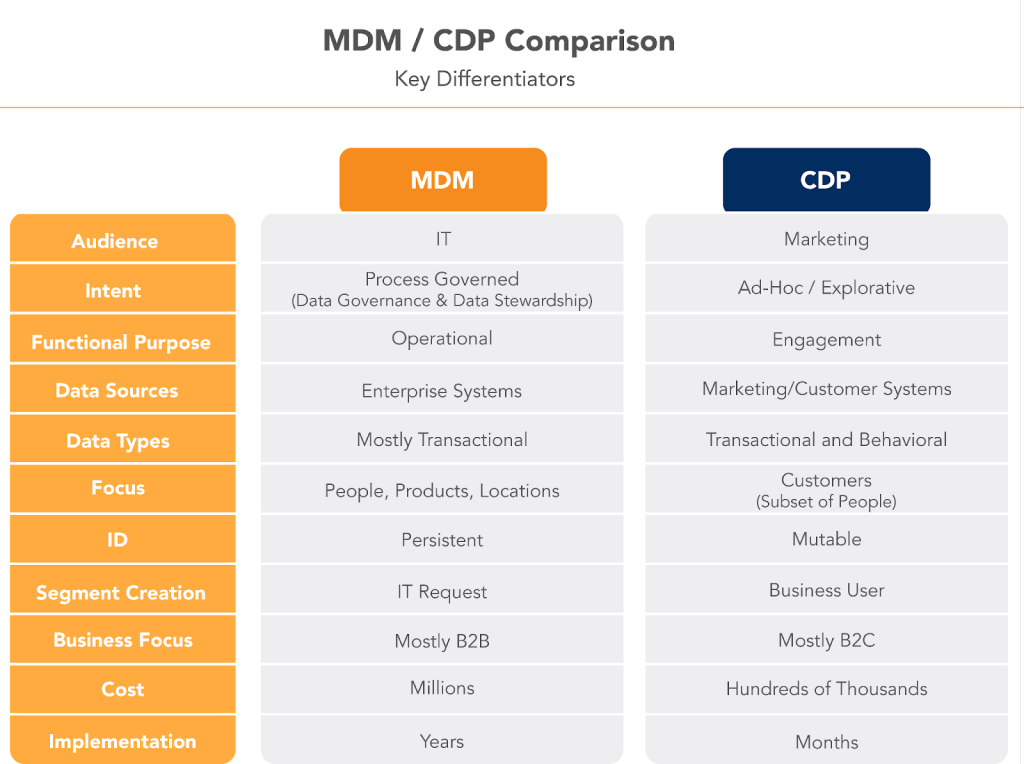
Salesforce customer data platform role in an enterprise architecture
The SOI describes CDPs’ functions accurately, but generally and can give somebody new to the platform a hint about how it fits into a more significant IT architecture. It resides above the Systems of Record and Systems of Engagement, but depends on them as data sources to derive business insights.
5 functions of a customer data platform
CDP helps people who work in customer or product marketing to understand their target customers better. The goal is to create a highly personalized customer experience, build loyalty, and establish trust in your brand. There are five essential functions that a CDP performs.
- Customer data unification and identity resolution: Pulling data from multiple customer data sources and resolving ambiguous customer records
- Customer insights and analytics: Understanding customer buying propensity, likelihood to churn, or satisfaction
- Individual-based marketing: Moving from channel-based marketing based on individuals
- Customer segmentation and activation: Creating relevant customer segments to drive marketing campaign success
- Real-time engagement across channels: The CDP should be plugged into data sources in real time so that analytics and insight are not stale. The next best action is most appropriate if the action is timely.
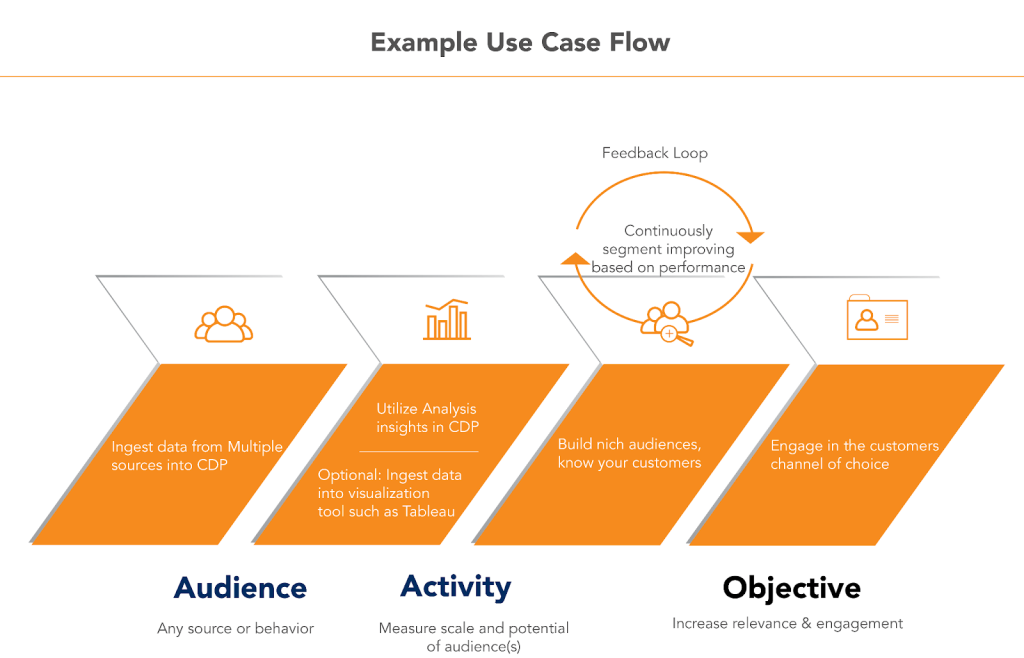
Integrating CDP using MuleSoft
While much of the functionality of the CDP Platform falls within the realm of marketing and data analysis, there are specific areas where an integration architect comes into the picture to set up and run the platform.
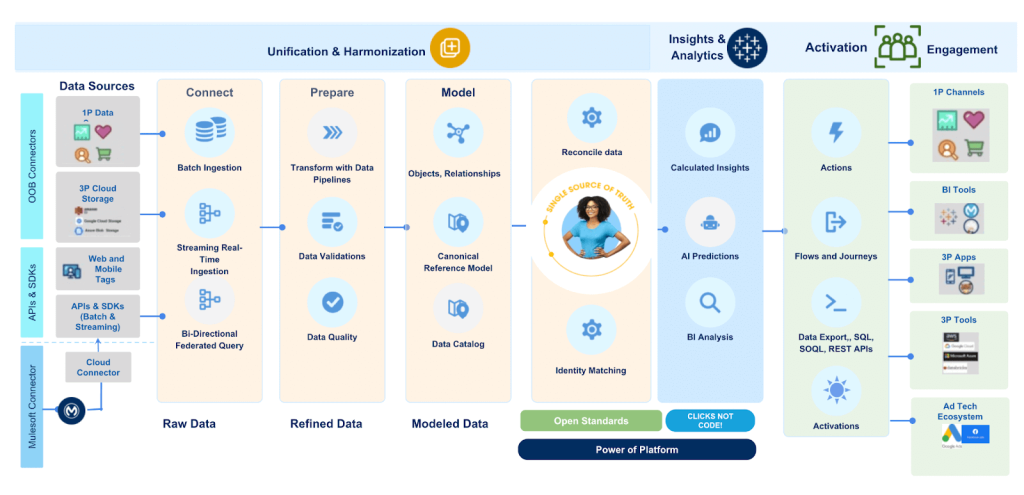
CDP needs a way to import data and expose the insights discovered when using the platform. MuleSoft provides a connector that can ingest data, disclose CDP information to external systems, and proactively notify external systems when events occur inside the CDP platform. This set of functions will integrate CDP into an organization’s broader customer MDM systems and can be used by MuleSoft architects and developers.
Bulk and streaming data ingestion
This function involves loading data into the CDP. It’s similar in concept to loading data into a general purpose data lake as implied CDP provides APIs for loading data in bulk or to stream in real-time changes to customer data.
Metadata query
This is an API that allows an external system to query the underlying data structure of the data that has been loaded in the CDP.
Data query
This is an API that allows an external system to query the data records that have been loaded in the CDP.
Calculated insight query
This API allows an external system to query the calculated insights that have been discovered and stored by the marketing team using the CDP platform. It is a vital concept. The calculated insights are the results of the data rules and analysis that the marketing team working with CDP has created. The entire goal of the system is to discover these insights, which is not at all surprising for a System of Insight.
Some examples of calculated insights could be:
- Lifetime value
- Propensity to buy
- Propensity to cancel service
- Next best action
- Cost of acquisition
Outbound data actions
This method allows CDP to interact with an external webhook to notify an external system when CDP has identified a critical insight or event. For example, suppose the propensity to cancel service for a customer with a high lifetime value hits a threshold. In that case, an outbound customer care team could be notified to reach out to the customer.
Example business scenarios
Four business scenarios illustrated below demonstrate how CDP should be integrated with Salesforce CRM and enterprise MDM platform, a service center, customer portals, and mobile apps.
- A customer opens a support case on a customer portal that requires streaming into CDP in real time.
- A real-time insight inside CDP has determined that a customer is at risk of canceling their service. It’s essential to notify a customer care team to reach out to the customer as soon as this insight has been determined.
- The sales team creates a new account or opportunity inside Salesforce. In this case, the new account data also needs to be added to CDP and the enterprise MDM platform.
- A customer self-registers using a mobile application. The customer information needs to be integrated into CDP, the CRM system, and the enterprise MDM platform.
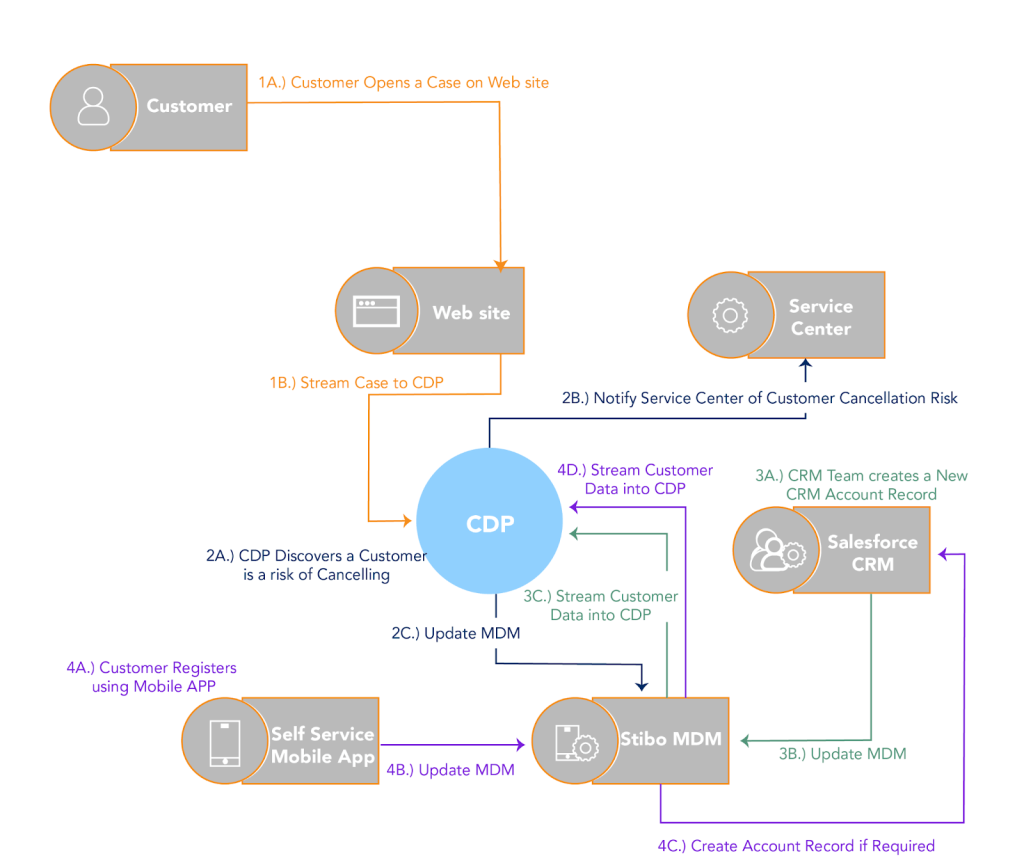
A MuleSoft reference architecture for CDP
The following diagram illustrates how this complex problem can be broken down and implemented in MuleSoft following an API-led approach. API-led is a pattern that has been proven to increase the ability to reuse components and save time and costs as an organization integrates systems over time.
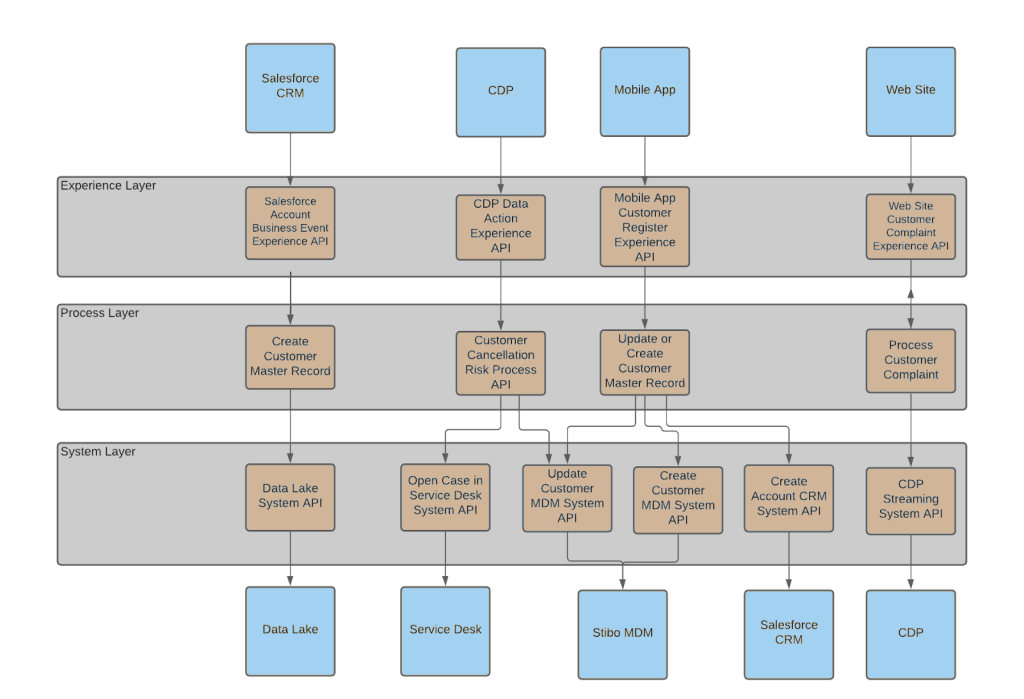
Conclusion
Digital innovation should drive new levels of engagement between the customer and the business. Nearly 90% of customers said they expect companies to accelerate digital initiatives. 84% of business buyers say they’re more likely to buy from a company that demonstrates an understanding of their business goals. While 66% of customers expect their brands to understand their unique needs and expectations. In reality, 34% of businesses treat customers as unique individuals.
With MuleSoft and Salesforce CDP’s joint power, it’s time to strengthen digital engagement to improve levels of digital customer experience. By following these simple steps, you will open a new world of connected experiences.









